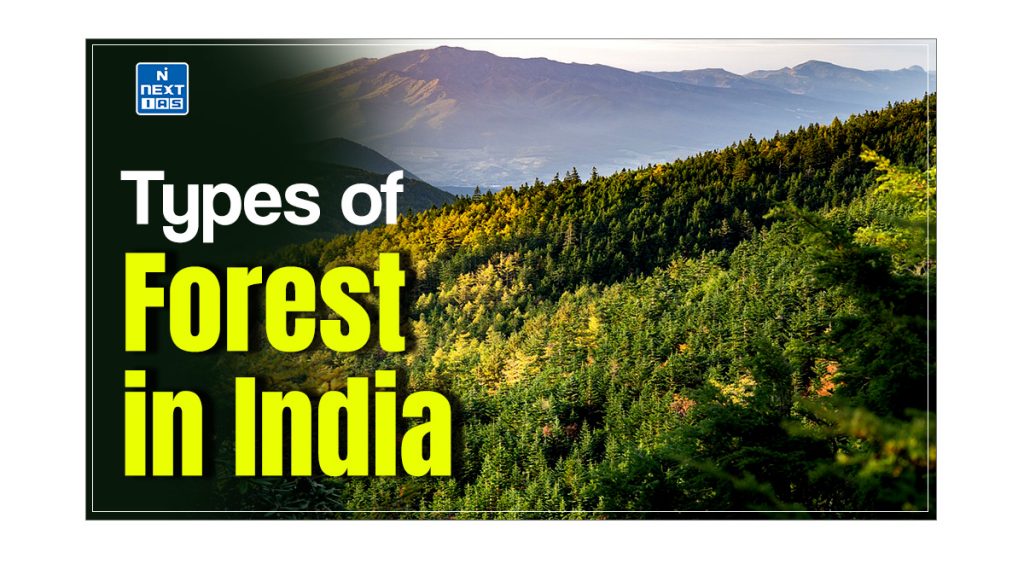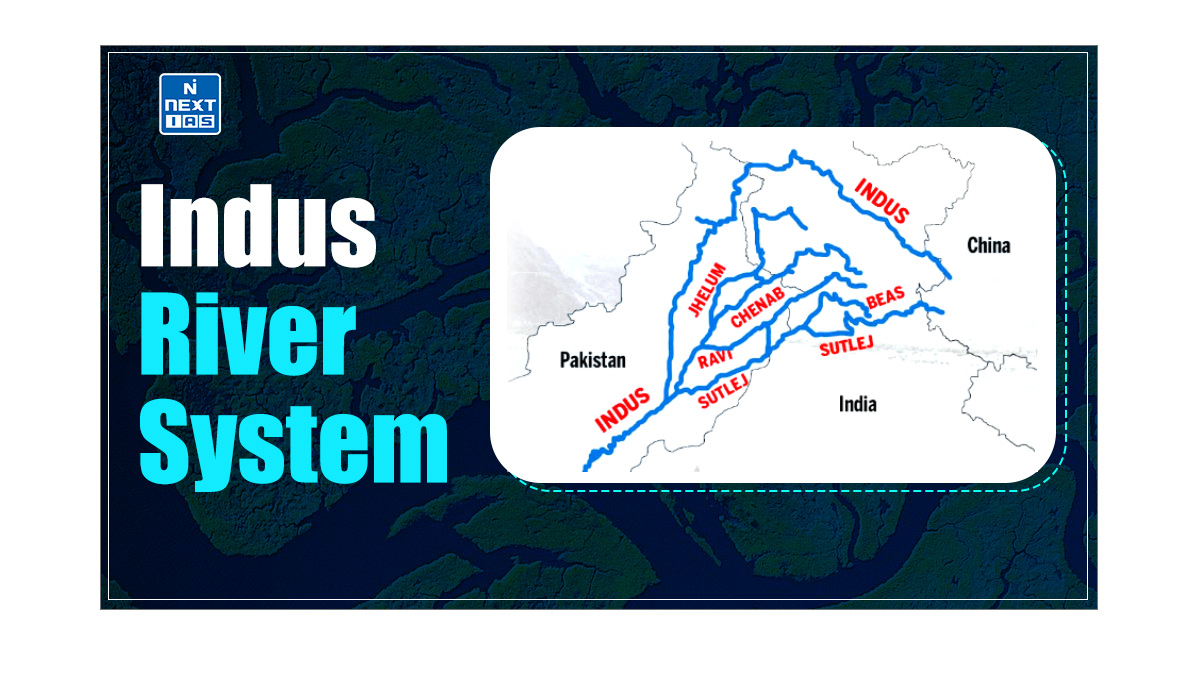
India’s diverse climate and topography give rise to various types of forest in india, each supporting distinct ecosystems. These forests are crucial in maintaining ecological balance, supporting biodiversity, and providing essential resources. This article aims to study in detail the different types of forests in India, their characteristics, climatic conditions, and distribution.
Types of Forests in India
India’s diverse climate and topography give rise to various types of forests, each supporting distinct ecosystems. The types of forests in India is primarily based on factors such as rainfall, temperature, and altitude. India’s vegetation can be divided into five main types, as given below:
- Moist Tropical Forests,
- Dry Tropical Forests,
- Montane Subtropical Forests,
- Montane Temperate Forests (MTF), and
- Alpine Forests.
All these types of forests in India have been discussed in detail in the following section.
Moist Tropical Forests in India
There are various categories of moist tropical forests, as follows:
Tropical Wet Evergreen Forests or Rain Forests in India
- Tropical rainforests are luxuriant forests found in wet tropical uplands and lowlands around the Equator.
- They are dominated by broad-leaved trees that form a dense upper canopy (layer of foliage) and contain a diverse array of vegetation and other life.
- Tropical rainforests comprise one of Earth’s largest biomes (major life zones).
Characteristics of Rain Forest in India
- Evergreen – These types of forests remain evergreen due to high heat and humidity. The trees do not shed their leaves together.
- Mesophytic – Plants adapted to neither too dry nor too wet climate.
- Thick Canopy – From the air, the tropical rainforest appears like a thick canopy of foliage.
- It is broken only when crossed by large rivers or cleared for cultivation.
- All plants struggle upwards (mostly epiphytes—a plant that grows non-parasitically on a tree or other plant) for sunlight, resulting in a peculiar layer arrangement.
- The entire morphology looks like a green carpet when viewed from above.
- Less Undergrowth – The thick canopy prevents sunlight from reaching the ground, leading to vegetation undergrowth. This undergrowth mainly comprises bamboo, ferns, climbers, orchids, etc.
Climatic Conditions
- The average annual rainfall exceeds 250 cm, the annual temperature is about 25°- 27°C, and the average annual humidity exceeds 77%.
- The dry season is distinctly short.
Distribution
- These types of forests are distributed in areas such as the Western side of the Western Ghats (500 to 1370 metres above sea level), some regions in the Purvanchal hills, and the Andaman and Nicobar Islands.
Timber
- The timber of these types of forests is fine-grained, hard, and durable, referred to as hardwood.
- It has high commercial value, but it is highly challenging to exploit due to its dense undergrowth, absence of pure stands, and lack of transport facilities.
- The important species of these types of forests are mahogany, mesua, rosewood, white cedar, Jackfruit, canes, bamboo, etc.
Tropical Semi-Evergreen Forests in India
- They are transitional forests between tropical wet evergreen forests and tropical deciduous forests.
- They are found in comparatively drier areas than tropical wet evergreen forests.
Characteristics
- The semi-evergreen forests are less dense. They are more gregarious [living in flocks or colonies – more pure stands] than the wet evergreen forests. These types of forests are characterised by many species.
- Trees usually have buttressed trunks with abundant epiphytes.
- The important species are laurel, rosewood, mesua, and thorny bamboo in the Western Ghats, White cedar, Indian chestnut, Champa, Mango, and others in the Himalayan region.
Climatic Conditions
- The average annual rainfall is 200-250 cm.
- The mean annual temperature varies from 24°C to 27°C, and the relative humidity is about 75 percent.
- The dry season is not as short as in the case of tropical evergreen forests.
Distribution
- These types of forests are distributed in areas such as the western coast, Assam, the lower slopes of the Eastern Himalayas, Odisha, and the Andaman and Nicobar Islands.
Timber
- Like tropical evergreen forests, these forests are less dense, have more pure stands (the timber industry here is better than evergreen forests), and have hardwood.
Tropical Moist Deciduous Forests in India
These are the most widespread types of forests in India and are popularly known as monsoon forests.
Characteristics
- The trees drop their leaves during the spring and early summer when sufficient moisture is unavailable.
- The general appearance is bare in extreme summers (April-May). Tropical moist deciduous forests present irregular top storey (25 to 60 m).
- Heavily buttressed trees and fairly complete undergrowth are the characteristics of these forests.
- These forests occupy a much larger area than the evergreen forests.
- However, large tracts under these forests have been cleared for cultivation.
Climatic Conditions
- The average annual rainfall is 100 to 200 cm, and the mean yearly temperature of these forests is about 27°C.
- The average annual relative humidity is around 60 to 75 per cent, the forests have Springs (between winter and summer), and the summer season is dry in nature.
Distribution
- They occur in the belt running along the Western Ghats surrounding the belt of evergreen forests.
- They also occur in a strip along the Shiwalik range, including Terai and Babar, from 77° E to 88° E.
- Thus, these types of forests are distributed regionally in the states of Manipur and Mizoram, the Hills of eastern Madhya Pradesh and Chhattisgarh, the Chota Nagpur Plateau, most of Odisha, parts of West Bengal, and the Andaman and Nicobar Islands.
Timber
- The main species found in these types of forests are teak, sal, amla, bamboo, Sheesham, sandalwood, and mahua.
- Due to their high degree of gregariousness (more pure stands), these types of forests are relatively easy to exploit.
Littoral and Swamp Forests in India
They can survive and grow in fresh and brackish water. Brackish water is a mixture of seawater and fresh water in estuaries, and its salinity can range from 0.5 to 35 ppt.
Distribution
- Littoral forests occur at several places along the coast, while swamp forests are confined to the deltas of the Ganges, Mahanadi, Godavari, Krishna, and Cauvery.
- Dense mangroves arise along the coastline in sheltered estuaries, tidal creeks, backwaters, salt marshes and mudflats.
- It provides valuable fuel for wood. It is most pronounced and densest in the Sunderban in the Ganga delta, where the predominant species is Sundri (Heriteera).
Timber
- It provides hard and durable timber used for construction, building purposes, and boat making.
- The important species found in these types of forests are Sundri, agar, rhizophora, screw pines, canes and palms, etc.
Dry Tropical Forests in India
There are various categories of dry tropical forests, as follows:
Tropical Dry Evergreen Forests in India
These types of forests also called as East Deccan dry evergreen forests, is an ecoregion of southeastern India.
Characteristics
- Here, we find short-statured trees up to 12 m high with a complete canopy. Bamboo and grasses are not conspicuous.
- The important species are jamun, tamarind, neem, etc.
- Most of the land under these types of forests has been cleared for agriculture or casuarina plantations.
Climatic Conditions
- The average annual rainfall of 100 cm, mainly from the north-east monsoon winds in October-December every year.
- The mean annual temperature is about 28°C, whereas the mean humidity is about 75%.
Distribution
- Casuarina is the most popular farm forestry in the states of Andhra Pradesh, Tamil Nadu, West Bengal, Odisha, Maharashtra, Gujarat and Karnataka.
Benefits
- These types of forests help reduce damage in the event of natural calamities. Line planting in coastal areas helps control wind force.
- It is also used for tourism promotion, given its ornamental appearance. It provides top-quality firewood.
- Wood is suitable for paper pulp and is a useful raw material for manufacturing paper for writing, printing, and wrapping. It also has serious medicinal value.
Tropical Dry Deciduous Forests In India
A dry deciduous forest is dominated by trees that lose their foliage at the end of the growing season. This is in contrast to an evergreen forest, where a majority of the trees remain “green” throughout the year because they shed leaves not seasonally but at various periods of the year.
Characteristics
- These are similar to moist deciduous forests and shed their leaves in the dry season.
- The major difference is that they can grow in areas with comparatively less rainfall.
- They represent a transitional type—moist deciduous on the wetter side and thorn forests on the drier side.
- They have a closed but uneven canopy. These types of forests are composed of a mixture of a few species of deciduous trees rising to 20 metres.
Climatic Conditions
- The average annual rainfall is 100-150 cm.
Distribution
- They occur in an irregular, wide strip running from the foot of the Himalayas to Kanyakumari, except in Rajasthan, the Western Ghats, and West Bengal.
- The important species are teak, maplewood, rosewood, common bamboo, red sanders, laurel, satinwood, etc.
- Large tracts of this forest have been cleared for agricultural purposes. These types of forests suffer from overgrazing, fire, etc.
Tropical Thorn Forests in India
A Thorn is a dense scrubland with vegetation characteristics of dry subtropical and warm temperate areas with seasonal rainfall.
Characteristics
- The trees are low (6 to 10 metres maximum) and widely scattered. Acacias and Euphorbias are very prominent. The Indian wild date is common. Some grasses also grow in the rainy season.
Climatic Conditions
- The average annual rainfall is less than 75 cm. Humidity is less than 50 per cent, and the mean temperature is 25°-30°C.
Distribution
- They are found in Rajasthan, southwestern Punjab, western Haryana, Kutch and neighbouring Saurashtra.
- Here, they degenerate into desert-type forests in the Thar desert. These types of forests also grow on the lee side of the Western Ghats, covering large areas of Maharashtra, Karnataka, Telangana, Andhra Pradesh, and Tamil Nadu.
- The important species are neem, babul, cacti, etc.
Montane Sub-Tropical Forests in India
There are various categories of montane sub-tropical forests as follows:
Sub-tropical Broad-leaved Hill Forests in India
The Himalayan subtropical broadleaf forests are an ecoregion that extends from the middle hills of central Nepal through Darjeeling into Bhutan and India.
Characteristics
- They form luxurious forests of evergreen species. They are relatively high (20-30 metres) and dense forests of evergreen species.
- Commonly found species are evergreen oaks, chestnuts, ash, beech, sals and pines. Climbers and epiphytes are common.
- These types of forests are less distinct in the southern parts of the country. They occur only in the Nilgiri and Palani hills, at 1070-1525 metres above sea level.
- It is a “stunted rain forest” less luxuriant than the true tropical evergreen. Sub-types of forests exist in the higher parts of the Western Ghats, such as Mahabaleshwar, the summits of the Satpura and the Maikal Range, and the highlands of Bastar and Mt. Abu in the Aravali Range.
Climatic conditions
- The mean annual rainfall is 75 cm to 125 cm. The average annual temperature is 18°-21°C where humidity is 80 per cent.
Distribution
- They are generally found in the Eastern Himalayas, east of 88°E longitude, at altitudes varying from 1000 to 2000 m.
Sub-tropical Moist Pine Forests in India
The subtropical pine forests represented by this ecoregion extend as a long, disjunct strip from Pakistan in the west, through the states of Jammu and Kashmir, Himachal Pradesh, and Uttar Pradesh in northern India, into Nepal and Bhutan.
Characteristics
- Compared with adjacent broadleaf forests, this ecoregion is neither exceptionally rich in species nor high in endemism.
- However, the region comprises various types of mammals in this ecosystem.
Distribution
- They are found in the Western Himalayas between 73°E and 88°E longitudes at elevations between 1000 and 2000 metres above sea level.
- Some hilly regions of Arunachal Pradesh, Manipur, Naga Hills, and Khasi Hills also witness their presence.
Timber
- Chir or Chil is the most dominant tree, forming pure stands. It provides valuable timber for furniture, boxes, and buildings.
- It is also used to produce resin and turpentine.
Sub-tropical Dry Evergreen Forests in India
A low scrub forest with small evergreen stunted trees and shrubs, including thorny species, herbs, and grasses. Olive, acacia modesta, and pistacia are the most predominant species.
Climatic Conditions
- The average annual rainfall is 50-100 cm (15 to 25 cm in December-March). The summers are sufficiently hot, and the winters are very cold.
Distribution
- It is found in the Bhabar, the Shiwaliks, and the western Himalayas up to 1000 metres above sea level.
Montane Temperate Forests in India
There are various categories of montane temperate forests, as follows:
Montane Wet Temperate Forests in India
- These are closed evergreen forests. The trunks have a large girth, and the branches are covered with mosses, ferns, and other epiphytes.
- The trees rarely achieve a height of more than 6 metres.
- Deodar, Chilauni, Indian chestnut, birch, plum, machilus, cinnamomum, litsea, magnolia, blue pine, oak, hemlock, etc. are essential species.
Climatic Conditions
- It grows at 1800 to 3000 m above sea level. The mean annual rainfall is 150 cm to 300 cm, whereas the mean annual temperature is about 11°C to 14°C, and the average relative humidity is over 80 per cent.
Distribution
- They are found in the higher hills of Tamil Nadu and Kerala in the Eastern Himalayan region.
Himalayan Moist Temperate Forests in India
- They mainly comprise coniferous species, which occur in mostly pure strands.
- Trees are 30 to 50 m high. The most important trees are pines, cedars, silver firs, spruce, etc.
- They form high and open forests with shrubby undergrowth, including oaks, rhododendrons, and some bamboo.
- These types of forests provide fine wood, which is of much use for construction, timber, and railway sleepers.
Climatic Conditions
- The average annual rainfall varies from 150 cm to 250 cm.
Distribution
- They occur in the temperate zone of the Himalayas between 1500 and 3300 metres, covering the entire length of this mountain range in Kashmir, Himachal Pradesh, Uttarakhand, Darjeeling and Sikkim.
Himalayan Dry Temperate Forests in India
- These types of forests have coniferous vegetation with xerophytic shrubs, with deodar, oak, ash, olive, etc., as the main trees.
Climatic Conditions
- Here, the precipitation is below 100 cm and is mainly in the form of snow.
Distribution
- Such types of forests are found in the inner dry ranges of the Himalayas, where the southwest monsoon is very feeble. These areas are in Ladakh, Lahul, Chamba, Kinnaur, Garhwal, and Sikkim.
Alpine Forests in India
- Alpine forests range between 2,900 and 3,500 metres in altitude. They can be divided into Sub-alpine, moist alpine scrub, and Dry alpine scrub. Sub-alpine forests occur in lower alpine scrub and grasslands.
- They are a mixture of coniferous and broad-leaved trees, with coniferous trees attaining a height of about 30 m while broad-leaved trees reach only up to 10 m.
- The important species are Fir, Spruce, Rhododendron, etc.
- The moist alpine scrub is a low evergreen dense growth of rhododendron, birch, etc, which occurs at 3,000 meters and extends up to the snowline.
- The dry alpine scrub is the uppermost limit of scrub xerophytic dwarf shrubs, found over 3,500 meters above sea level in the dry zone.
- Juniper, honeysuckle, artemesia, etc., are important species.
| Share of Different Types of Forest in India | |
| Types of Forests in India | Total Forest Area (%) |
| Tropical Moist Deciduous | 37 |
| Tropical Dry Deciduous | 28 |
| Tropical Wet Evergreen | 8 |
| Montane Sub-Tropical moist (Pine) | 6.6 |
| Tropical Semi-Evergreen | 4 |
| Montane Wet Temperate | 3.6 |
| Alpine | 2.1 |
| Littoral and Swamp | 0.6 |
Conclusion
The types of forests in India are a testament to the country’s ecological diversity, shaped by varying climatic and geographical factors. Each forest type, from the tropical wet evergreen forests to the alpine scrubs, plays a vital role in maintaining ecological balance, supporting wildlife, and providing essential resources. Conservation efforts must continue to focus on preserving these diverse forest ecosystems to sustain their ecological, economic, and cultural importance. By understanding the characteristics and distribution of these types of forests, we can better appreciate their significance and work towards their protection and sustainable use.
Frequently Asked Questions (FAQs)
How many types of forests in India?
India has diverse forest types due to its climate and topography such as Tropical Evergreen Forests, Tropical Deciduous Forests, Tropical Thorn Forest, Mangrove Forest and more.
What are the 5 types of forest in India?
The 5 types of forests in India are:
– Tropical Evergreen Forest,
– Tropical Deciduous Forest,
– Tropical Thorn Forest,
– Montane Forest, and
– Mangrove Forest.






